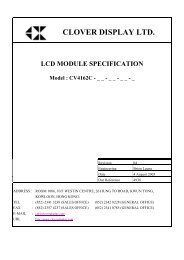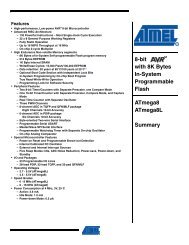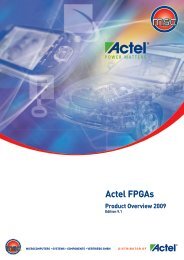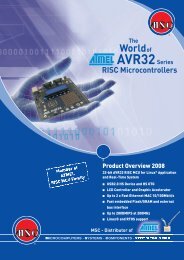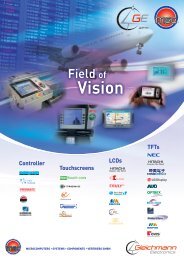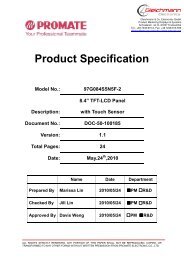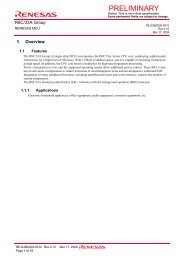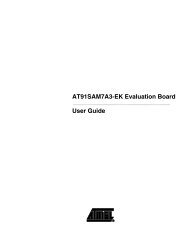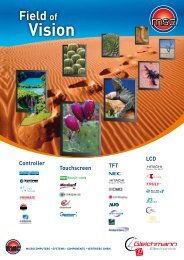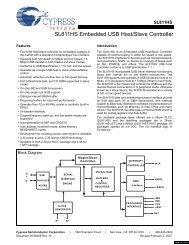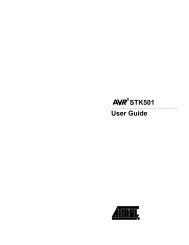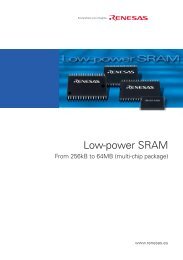Artikel-Nr.: MSC-C204DYLY-1N
Artikel-Nr.: MSC-C204DYLY-1N
Artikel-Nr.: MSC-C204DYLY-1N
- No tags were found...
You also want an ePaper? Increase the reach of your titles
YUMPU automatically turns print PDFs into web optimized ePapers that Google loves.
<strong>Artikel</strong>-<strong>Nr</strong>.: <strong>MSC</strong>-<strong>C204DYLY</strong>-<strong>1N</strong>Gleichmann & Co. Electronics GmbHIndustriestr. 1676297 StutenseeTel.: (07249) 910-151Fax: (07249) 4232Email: rbo@msc-ge.comInternet: www.msc-ge.com
LCD MODULE <strong>MSC</strong>-<strong>C204DYLY</strong>-<strong>1N</strong> Version : 1.0 Jul 22, 1998PRODUCT SPECIFICATIONS PHYSICAL DATA EXTERNAL DIMENSIONS BLOCK DIAGRAM ABSOLUTE MAXIMUM RATINGS ELECTRICAL CHARACTERISTICS OPERATING PRINCIPLES & METHODS DISPLAY DATA RAM ADDRESS MAP ELECTRO-OPTICAL CHARACTERISTICS INTERFACE PIN CONNECTIONS PART LIST CIRCUIT DIAGRAM RELIABILITY QUALITY GUARANTEE INSPECTION CRITERIA PRECAUTIONS FOR USING LCD MODULES USING LCD MODULESTRULY SEMICONDUCTORS LTD. P.1 of 19
PHYSICAL DATALCD MODULE <strong>MSC</strong>-<strong>C204DYLY</strong>-<strong>1N</strong> Version : 1.0 Jul 22, 1998Item Contents UnitLCD type STN ---LCD duty 1/16 ---LCD bias 1/5 ---Viewing direction 6 o’clockModule size (W×H×T) 98 × 60 × 14MAX (3.86″ × 2.36″ × 0.55″MAX) mmViewing area (W×H) 76 × 25.2 (2.99″ × 0.99″) mmNumber of characters20 × 4 ---(characters×lines)Character matrix (W×H) 5 × 8 dotsCharacter size (W×H) 3.55 × 5.35 (0.140″ × 0.211″) mmDot size (W×H) 0.55 × 0.55 (0.022″ × 0.022″) mmDot pitch (W×H) 0.60 × 0.60 (0.024″ × 0.024″) mm EXTERNAL DIMENSIONSTRULY SEMICONDUCTORS LTD. P.2 of 19
LCD MODULE <strong>MSC</strong>-<strong>C204DYLY</strong>-<strong>1N</strong> Version : 1.0 Jul 22, 1998 BLOCK DIAGRAM1 2 3 4 5 6 7 8 9 10 11 12 13 14 15 16VSS VDD VO RS R/W E DB0 DB1 DB2 DB3 DB4 DB5 DB6 DB7 BLA BLKDB0~DB7RSR/WEVSSVDDVOBLABLKCONTROLLER ICKS0076BControl signals 4COM16SEG40SEGMENT DRIVER ICKS0063B ✕ 2SEG160LCD PANEL20 CHARACTERS ✕ 4 LINESLED BACK LIGHTTRULY SEMICONDUCTORS LTD. P.3 of 19
LCD MODULE <strong>MSC</strong>-<strong>C204DYLY</strong>-<strong>1N</strong> Version : 1.0 Jul 22, 1998 ABSOLUTE MAXIMUM RATINGS ( Ta = 25°C )Parameter Symbol Min Max UnitSupply voltage for logic VDD -0.3 7.0 VSupply voltage for LCD VDD - VO -0.3 VDD+0.3 VInput voltage VI -0.3 VDD+0.3 VOperating temperature TOP 0 50 °CStorage temperature TST -10 60 °C ELECTRICAL CHARACTERISTICS ( VDD = +5V±10% , VSS = 0V, Ta = 25°C )u DC CharacteristicsParameter Symbol Condition Min Typ Max UnitSupply voltage for logic VDD --- 4.5 5.0 5.5 VSupply current for logic IDD --- --- 1.44 4 mA0°C 4.7 5.0 5.3 VOperating voltage for LCD VDD - VO 25°C 4.5 4.8 5.1 V50°C 4.4 4.7 5.0 VSupply voltage for back light VF --- --- 4.2 4.6 VSupply current for back light IF VF=4.2V --- 280 480 mAInput voltage ' H ' level VIH --- VDD - 2.2 --- VDD VInput voltage ' L ' level VIL --- 0 --- 0.8 Vu AC Characteristics Write modeCharacteristic Symbol Min. Typ. Max. Unit Test pinE cycle time t C 500 --- --- ns EE rise time t r --- --- 25 ns EE fall time t f --- --- 25 ns EE pulse width (High, Low) t W 220 --- --- ns ER/W and RS set-up time t SU1 40 --- --- ns R/W, RSR/W and RS hold time t h1 10 --- --- ns R/W, RSData set-up time t SU2 60 --- --- ns DB 0 ~ DB 7Data hold time t h2 10 --- --- ns DB 0 ~ DB 7TRULY SEMICONDUCTORS LTD. P.4 of 19
LCD MODULE <strong>MSC</strong>-<strong>C204DYLY</strong>-<strong>1N</strong> Version : 1.0 Jul 22, 1998 Read modeCharacteristic Symbol Min. Typ. Max. Unit Test pinE cycle time t C 500 --- --- ns EE rise time t r --- --- 25 ns EE fall time t f --- --- 25 ns EE pulse width t W 220 --- --- ns ER/W and RS set-up time t SU 40 --- --- ns R/W, RSR/W and RS hold time t h 10 --- --- ns R/W, RSData output delay time t D --- --- 120 ns DB 0 ~ DB 7Data hold time t DH 20 --- --- ns DB 0 ~ DB 7 Interface mode with ,KS0063BCharacteristic Symbol Min. Typ. Max. Unit Test pinClock pulse width High t CWH 800 --- --- ns CLKClock pulse width Low t CWL 800 --- --- ns CLKData set-up time t SU 300 --- --- ns DB 0 ~ DB 7Data hold time t DH 300 --- --- ns DB 0 ~ DB 7Clock set-up time t CSU 500 --- --- ns CLKM Delay time t DM -1000 --- 1000 ns MTRULY SEMICONDUCTORS LTD. P.5 of 19
u Initializing by Internal Reset CircuitLCD MODULE <strong>MSC</strong>-<strong>C204DYLY</strong>-<strong>1N</strong> Version : 1.0 Jul 22, 1998The KS0076B automatically initializes (resets) when the power is on using the internal reset circuit. The followinginstruction are executed in initialization. The busy flag is kept in busy state (BF=1) until initialization ends. The busy stateis 10ms after VDD rises to 4.5V.(1) Display Clear(2) Function SetDL = 1 : 8-bit interface dataN = 0 : 1-line displayF = 0 : 5x7-dot character font(3) Display On/Off ControlD = 0 : Display OffC = 0 : Cursor OffB = 0 : Blink Off(4) Entry Mode SetI/D = 1 : +1 (Increment)S = 0 : No Shiftu Initializing by InstructionPower On|Wait for more than 15ms after VDD rises to 4.5V|RS R/W DB7 DB6 DB5 DB4 DB3 DB2 DB1 DB00 0 0 0 1 1 * * * *|Wait for more than 4.1ms|RS R/W DB7 DB6 DB5 DB4 DB3 DB2 DB1 DB00 0 0 0 1 1 * * * *|Wait for more than 100µs|RS R/W DB7 DB6 DB5 DB4 DB3 DB2 DB1 DB00 0 0 0 1 1 * * * *||||||RS R/W DB7 DB6 DB5 DB4 DB3 DB2 DB1 DB00 0 0 0 1 1 N F * *BF cannot be checked before thisinstruction.Function SetBF cannot be checked before thisinstruction.Function SetBF cannot be checked before thisinstruction.Function Set0 0 0 0 0 0 1 0 0 0 Display Off0 0 0 0 0 0 0 0 0 1 Display Clear0 0 0 0 0 0 0 1 I/D S Entry Mode Set|Initialization endsBF can be checked after followinginstruction.When BF is not checked, the waiting timebetween instructions is longer thanexecution instruction time.Function Set (Specify the number ofdisplay lines and character font.) Thenumber of display lines and character fontcannot be changed afterwards.TRULY SEMICONDUCTORS LTD. P.8 of 19
u Standard Character PatternLCD MODULE <strong>MSC</strong>-<strong>C204DYLY</strong>-<strong>1N</strong> Version : 1.0 Jul 22, 1998TRULY SEMICONDUCTORS LTD. P.9 of 19
LCD MODULE <strong>MSC</strong>-<strong>C204DYLY</strong>-<strong>1N</strong> Version : 1.0 Jul 22, 1998 DISPLAY DATA RAM ADDRESS MAPCharacters 1 2 3 4 5 6 7 8 9 10 11 12 13 14 15 16 17 18 19 20First line (H) 00 01 02 03 04 05 06 07 08 09 0A 0B 0C 0D 0E 0F 10 11 12 13Second line (H) 40 41 42 43 44 45 46 47 48 49 4A 4B 4C 4D 4E 4F 50 51 52 53Third line (H) 14 15 16 17 18 19 1A 1B 1C 1D 1E 1F 20 21 22 23 24 25 26 27Fourth line (H) 54 55 56 57 58 59 5A 5B 5C 5D 5E 5F 60 61 62 63 64 65 66 67 ELECTRO-OPTICAL CHARACTERISTICS ( VOP = 4.8V, Ta = 25°C )Item Symbol Condition Min Typ Max Unit Remarks NoteResponse time Tr --- --- 275 --- ms --- 1Tf --- --- 61 --- ms --- 1Contrast ratio Cr --- --- 30.1 --- --- --- 248 --- --- deg ∅ = 90° 3Viewing angle range θ Cr ≥ 2 47 --- --- deg ∅ = 270° 360 --- --- deg ∅ = 0° 357 --- --- deg ∅ = 180° 3Note1: Definition of response time.Note2: Definition of contrast ratio ‘Cr’ .Note3: Definition of viewing angle range ‘θ’.TRULY SEMICONDUCTORS LTD. P.10 of 19
LCD MODULE <strong>MSC</strong>-<strong>C204DYLY</strong>-<strong>1N</strong> Version : 1.0 Jul 22, 1998 INTERFACE PIN CONNECTIONSPin NO. Symbol Level Description1 VSS 0V Ground2 VDD 5.0V Supply voltage for logic3 VO --- Input voltage for LCD4 RS H/L H : Data signal, L : Instruction signal5 R/W H/L H : Read mode, L : Write mode6 E H, H → L Enable signal for KS00767 DB0 H/L Data bit 08 DB1 H/L Data bit 19 DB2 H/L Data bit 210 DB3 H/L Data bit 311 DB4 H/L Data bit 412 DB5 H/L Data bit 513 DB6 H/L Data bit 614 DB7 H/L Data bit 715 BLA 4.2V Back light anode16 BLK 0V Back light cathode PART LISTPart Name Description QuantityIC KS0076B.PCC 1IC KS0063B.PCC 2LCD TSB0008-DYFDCN 1PCB MCC204B1-3 1Frame MC204-1B 1Rubber connector 96 x 6.5 x 3.5 mm 2Resistor 2.2KΩ 5Resistor 91KΩ 1LED PCB LB204A1-3 1LED light ED-011YGU 48TRULY SEMICONDUCTORS LTD. P.11 of 19
CIRCUIT DIAGRAMLCD MODULE <strong>MSC</strong>-<strong>C204DYLY</strong>-<strong>1N</strong> Version : 1.0 Jul 22, 1998TRULY SEMICONDUCTORS LTD. P.12 of 19
LCD MODULE <strong>MSC</strong>-<strong>C204DYLY</strong>-<strong>1N</strong> Version : 1.0 Jul 22, 1998 RELIABILITYu Content of Reliability TestEnvironmental TestNo. Test Item Content of Test Test Condition ApplicableStandard1 High temperature Endurance test applying the high storage 60 °C------storagetemperature for a long time.200 hrs2 Low temperaturestorageEndurance test applying the low storagetemperature for a long time.-10 °C200 hrs------3 High temperatureoperation4 Low temperatureoperation5 High temperature /Humidity storage6 High temperature /Humidity operationEndurance test applying the electric stress(Voltage & Current) and the thermal stressto the element for a long time.Endurance test applying the electric stressunder low temperature for a long time.Endurance test applying the hightemperature and high humidity storage for along time.Endurance test applying the electric stress(Voltage & Current) and temperature /humidity stress to the element for a longtime.7 Temperature cycle Endurance test applying the low and hightemperature cycle.-10°C 25°C 60°C30min 5min. 30minMechanical Test8 Vibration test Endurance test applying the vibrationduring transportation and using.9 Shock test Constructional and mechanical endurancetest applying the shock duringtransportation.10 Atmosphericpressure testEndurance test applying the atmosphericpressure during transportation by air.Others11 Static electricity test Endurance test applying the electric stress tothe terminal.50 °C200 hrs ------0 °C200 hrs60 °C , 90 %RH96 hrs40 °C , 90 %RH96 hrs-10°C / 60°C10 cycles10∼22Hz → 1.5mmp-p22∼500Hz → 1.5GTotal 0.5hrs50G half signwave 1l msedc3 times of eachdirection115 mbar40 hrsVS=800V , RS=1.5 kΩCS=100 pF1 time∗∗∗ Supply voltage for logic system = 5V. Supply voltage for LCD system = Operating voltage at 25°C.u Failure Judgement CriterionCriterion Item Test Item No. Failure Judgment CriterionBasic specificationElectrical characteristicMechanical charactersticOptical characterstic1 cycle------MIL-202E-103BJIS-C5023MIL-202E-103BJIS-C5023------MIL-202E-201AJIS-C5025JIS-C7022-A-10MIL-202E-213BMIL-202E-105CMIL-883B-3015.11 2 3 4 5 6 7 8 9 10 11Out of the Basic SpecificationOut of the DC and AC CharactersticOut of the Mechanical Specification Colorchange : Out of Limit ApperanceSpecificationOut of the Apperance StandardTRULY SEMICONDUCTORS LTD. P.13 of 19
QUALITY GUARANTEELCD MODULE <strong>MSC</strong>-<strong>C204DYLY</strong>-<strong>1N</strong> Version : 1.0 Jul 22, 1998u Acceptable Quality LevelEach lot should satisfy the quality level defined as follows.- Inspection method : MIL-STD-105E LEVEL II Normal one time sampling- AQLPartition AQL DefinitionA: Major 0.4% Functional defective as productB: Minor 1.5% Satisfy all functions as product but not satisfy cosmetic standardu Definition of ‘LOT’One lot means the delivery quantity to customer at one time.u Conditions of Cosmetic Inspection Environmental conditionThe inspection should be performed at the 1m of height from the LCD module under 2 pieces of 40W whitefluorescent lamps (Normal temperature 20∼25°C and normal humidity 60±15%RH). Inspection methodThe visual check should be performed vertically at more than 30cm distance from the LCD panel. Driving voltageThe VO value which the most optimal contrast can be obtained near the specified VO in the specification. (Within±0.5V of the typical value at 25°C.). INSPECTION CRITERIAu Module Cosmetic CriteriaNo. Item Judgement Criterion Partition1 Difference in Spec. None allowed Major2 Pattern peeling No substrate pattern peeling and floating Major3 Soldering defects No soldering missingNo soldering bridgeNo cold solderingMajorMajorMinor4 Resist flaw on substrate Invisible copper foil (∅0.5mm or more) on substrate pattern Minor5 Accretion of metallicForeign matterNo soldering dustNo accretion of metallic foreign matters (Not exceed ∅0.2mm)MinorMinor6 Stain No stain to spoil cosmetic badly Minor7 Plate discoloring No plate fading, rusting and discoloring Minor8 Solder amount1. Lead partsa. Soldering side of PCBSolder to form a ‘Filet’all around the lead.Solder should not hide thelead form perfectly. (too much)b. Components side( In case of ‘Through Hole PCB’ )MinorSolder to reach the Components side of PCB.2. Flat packages Either ‘toe’ (A) or ‘heal’ (B) ofthe lead to be covered by ‘Filet’.ABMinorLead form to be assume oversolder.3. Chips (3/2) H ≥ h ≥ (1/2) H MinorH hTRULY SEMICONDUCTORS LTD. P.14 of 19
LCD MODULE <strong>MSC</strong>-<strong>C204DYLY</strong>-<strong>1N</strong> Version : 1.0 Jul 22, 1998u Screen Cosmetic Criteria (Non-Operating)No. Defect Judgement Criterion Partition1 Spots In accordance with Screen Cosmetic Criteria (Operating) No.1. Minor2 Lines In accordance with Screen Cosmetic Criteria (Operating) No.2. Minor3 Bubbles in polarizerSize : d mmAcceptable Qty in active areaMinord ≤ 0.3Disregard0.3 < d ≤ 1.0 31.0 < d ≤ 1.5 11.5 < d 04 Scratch In accordance with spots and lines operating cosmetic criteria. When the Minorlight reflects on the panel surface, the scratches are not to be remarkable.5 Allowable density Above defects should be separated more than 30mm each other. Minor6 Coloration Not to be noticeable coloration in the viewing area of the LCD panels.Back-lit type should be judged with back-lit on state only.Minor7 Contamination Not to be noticeable. Minoru Screen Cosmetic Criteria (Operating)No. Defect Judgement Criterion Partition1 Spots A) ClearMinorSize : d mmAcceptable Qty in active aread ≤ 0.1Disregard0.1 < d ≤ 0.2 60.2 < d ≤ 0.3 20.3 < d 0Note : Including pin holes and defective dots which must be within onepixel size.B) UnclearSize : d mmAcceptable Qty in active aread ≤ 0.2Disregard0.2 < d ≤ 0.5 60.5 < d ≤ 0.7 20.7 < d 02 Lines A) ClearL 5.02.0∞0.02(6)0.05(0)Note : ( ) - Acceptable Qty in active areaL - Length (mm)W - Width (mm)∞ - DisregardB) Unclear0.1See No. 1WMinorL 10.0∞(6)(0)2.00.050.30.5See No. 1W‘Clear’ = The shade and size are not changed by VO.‘Unclear’ = The shade and size are changed by VO.TRULY SEMICONDUCTORS LTD. P.15 of 19
LCD MODULE <strong>MSC</strong>-<strong>C204DYLY</strong>-<strong>1N</strong> Version : 1.0 Jul 22, 1998u Screen Cosmetic Criteria (Operating) (Continued)No. Defect Judgement Criterion Partition3 Rubbing line Not to be noticeable.4 Allowable density Above defects should be separated more than 10mm each other. Minor5 Rainbow Not to be noticeable. Minor6 Dot size To be 95% ∼ 105% of the dot size (Typ.) in drawing.Partial defects of each dot (ex. pin-hole) should be treated as ‘spot’.(see Screen Cosmetic Criteria (Operating) No.1)Minor7 Uneven brightness(only back-lit typemodule)Uneven brightness must be BMAX / BMIN ≤ 2- BMAX : Max. value by measure in 5 points- BMIN : Min. value by measure in 5 pointsDivide active area into 4 vertically and horizontally.Measure 5 points shown in the following figure.Minor : Measuring pointsNote :(1) Size : d = (long length + short length) / 2(2) The limit samples for each item have priority.(3) Complexed defects are defined item by item, but if the number of defects are defined in above table, the totalnumber should not exceed 10.(4) In case of ‘concentration’, even the spots or the lines of ‘disregarded’ size should not allowed. Following threesituations should be treated as ‘concentration’.- 7 or over defects in circle of ∅5mm.- 10 or over defects in circle of ∅10mm.- 20 or over defects in circle of ∅20mm. PRECAUTIONS FOR USING LCD MODULESu Handing Precautions(1) The display panel is made of glass. Do not subject it to a mechanical shock by dropping it or impact.(2) If the display panel is damaged and the liquid crystal substance leaks out, be sure not to get any in your mouth. Ifthe substance contacts your skin or clothes, wash it off using soap and water.(3) Do not apply excessive force to the display surface or the adjoining areas since this may cause the color tone to vary.(4) The polarizer covering the display surface of the LCD module is soft and easily scratched. Handle this polarizercarefully.(5) If the display surface becomes contaminated, breathe on the surface and gently wipe it with a soft dry cloth. If it isheavily contaminated, moisten cloth with one of the following solvents :- Isopropyl alcohol- Ethyl alcohol(6) Solvents other than those above-mentioned may damage the polarizer. Especially, do not use the following.- Water- Ketone- Aromatic solvents(7) Exercise care to minimize corrosion of the electrode. Corrosion of the electrodes is accelerated by water droplets,moisture condensation or a current flow in a high-humidity environment.TRULY SEMICONDUCTORS LTD. P.16 of 19
LCD MODULE <strong>MSC</strong>-<strong>C204DYLY</strong>-<strong>1N</strong> Version : 1.0 Jul 22, 1998(8) Install the LCD Module by using the mounting holes. When mounting the LCD module make sure it is free oftwisting, warping and distortion. In particular, do not forcibly pull or bend the I/O cable or the backlight cable.(9) Do not attempt to disassemble or process the LCD module.(10) NC terminal should be open. Do not connect anything.(11) If the logic circuit power is off, do not apply the input signals.(12) To prevent destruction of the elements by static electricity, be careful to maintain an optimum work environment.- Be sure to ground the body when handling the LCD modules.- Tools required for assembling, such as soldering irons, must be properly grounded.- To reduce the amount of static electricity generated, do not conduct assembling and other work under dryconditions.- The LCD module is coated with a film to protect the display surface. Exercise care when peeling off this protectivefilm since static electricity may be generated.u Storage PrecautionsWhen storing the LCD modules, avoid exposure to direct sunlight or to the light of fluorescent lamps. Keep the modulesin bags (avoid high temperature / high humidity and low temperatures below 0°C). Whenever possible, the LCD modulesshould be stored in the same conditions in which they were shipped from our company.u OthersLiquid crystals solidify under low temperature (below the storage temperature range) leading to defective orientationor the generation of air bubbles (black or white). Air bubbles may also be generated if the module is subject to a lowtemperature.If the LCD modules have been operating for a long time showing the same display patterns, the display patterns mayremain on the screen as ghost images and a slight contrast irregularity may also appear. A normal operating status can beregained by suspending use for some time. It should be noted that this phenomenon does not adversely affect performancereliability.To minimize the performance degradation of the LCD modules resulting from destruction caused by static electricityetc., exercise care to avoid holding the following sections when handling the modules.- Exposed area of the printed circuit board.- Terminal electrode sections. USING LCD MODULESu Liquid Crystal Display ModulesLCD is composed of glass and polarizer. Pay attention to the following items when handling.(1) Please keep the temperature within specified range for use and storage. Polarization degradation, bubble generationor polarizer peel-off may occur with high temperature and high humidity.(2) Do not touch, push or rub the exposed polarizers with anything harder than an HB pencil lead (glass, tweezers, etc.).(3) N-hexane is recommended for cleaning the adhesives used to attach front/rear polarizers and reflectors made oforganic substances which will be damaged by chemicals such as acetone, toluene, ethanol and isopropylalcohol.(4) When the display surface becomes dusty, wipe gently with absorbent cotton or other soft material like chamoissoaked in petroleum benzin. Do not scrub hard to avoid damaging the display surface.(5) Wipe off saliva or water drops immediately, contact with water over a long period of time may cause deformation orcolor fading.(6) Avoid contacting oil and fats.(7) Condensation on the surface and contact with terminals due to cold will damage, stain or dirty the polarizers. Afterproducts are tested at low temperature they must be warmed up in a container before coming is contacting with roomtemperature air.(8) Do not put or attach anything on the display area to avoid leaving marks on.(9) Do not touch the display with bare hands. This will stain the display area and degradate insulation betweenterminals (some cosmetics are determinated to the polarizers).(10) As glass is fragile. It tends to become or chipped during handling especially on the edges. Please avoid dropping orjarring.TRULY SEMICONDUCTORS LTD. P.17 of 19
LCD MODULE <strong>MSC</strong>-<strong>C204DYLY</strong>-<strong>1N</strong> Version : 1.0 Jul 22, 1998u Installing LCD ModulesThe hole in the printed circuit board is used to fix LCM as shown in the picture below. Attend to the following itemswhen installing the LCM.(1) Cover the surface with a transparent protective plate to protect the polarizer and LC cell.(2) When assembling the LCM into other equipment, the spacer to the bit between the LCM and the fitting plate shouldhave enough height to avoid causing stress to the module surface, refer to the individual specifications for measurements.The measurement tolerance should be ±0.1mm.u Precaution for Handing LCD ModulesSince LCM has been assembled and adjusted with a high degree of precision, avoid applying excessive shocks to themodule or making any alterations or modifications to it.(1) Do not alter, modify or change the the shape of the tab on the metal frame.(2) Do not make extra holes on the printed circuit board, modify its shape or change the positions of components to beattached.(3) Do not damage or modify the pattern writing on the printed circuit board.(4) Absolutely do not modify the zebra rubber strip (conductive rubber) or heat seal connector.(5) Except for soldering the interface, do not make any alterations or modifications with a soldering iron.(6) Do not drop, bend or twist LCM.u Electro-Static Discharge ControlSince this module uses a CMOS LSI, the same careful attention should be paid to electrostatic discharge as for anordinary CMOS IC.(1) Make certain that you are grounded when handing LCM.(2) Before remove LCM from its packing case or incorporating it into a set, be sure the module and your body have thesame electric potential.(3) When soldering the terminal of LCM, make certain the AC power source for the soldering iron does not leak.(4) When using an electric screwdriver to attach LCM, the screwdriver should be of ground potentiality to minimize asmuch as possible any transmission of electromagnetic waves produced sparks coming from the commutator of the motor.(5) As far as possible make the electric potential of your work clothes and that of the work bench the ground potential.(6) To reduce the generation of static electricity be careful that the air in the work is not too dried. A relative humidityof 50%-60% is recommended.u Precaution for soldering to the LCM(1) Observe the following when soldering lead wire, connector cable and etc. to the LCM.- Soldering iron temperature : 280°C ± 10°C.- Soldering time : 3-4 sec.- Solder : eutectic solder.If soldering flux is used, be sure to remove any remaining flux after finishing to soldering operation. (This does notapply in the case of a non-halogen type of flux.) It is recommended that you protect the LCD surface with a cover duringsoldering to prevent any damage dur to flux spatters.(2) When soldering the electroluminescent panel and PC board, the panel and board should not be detached more thanthree times. This maximum number is determined by the temperature and time conditions mentioned above, though theremay be some variance depending on the temperature of the soldering iron.(3) When remove the electoluminescent panel from the PC board, be sure the solder has completely melted, the solderedpad on the PC board could be damaged.TRULY SEMICONDUCTORS LTD. P.18 of 19
LCD MODULE <strong>MSC</strong>-<strong>C204DYLY</strong>-<strong>1N</strong> Version : 1.0 Jul 22, 1998u Precautions for Operation(1) Viewing angle varies with the change of liquid crystal driving voltage (VO). Adjust VO to show the best contrast.(2) Driving the LCD in the voltage above the limit shortens its life.(3) Response time is greatly delayed at temperature below the operating temperature range. However, this does notmean the LCD will be out of the order. It will recover when it returns to the specified temperature range.(4) If the display area is pushed hard during operation, the display will become abnormal. However, it will return tonormal if it is turned off and then back on.(5) Condensation on terminals can cause an electrochemical reaction disrupting the terminal circuit. Therefore, it mustbe used under the relative condition of 40°C , 50% RH.(6) When turning the power on, input each signal after the positive/negative voltage becomes stable.u StorageWhen storing LCDs as spares for some years, the following precaution are necessary.(1) Store them in a sealed polyethylene bag. If properly sealed, there is no need for dessicant.(2) Store them in a dark place. Do not expose to sunlight or fluorescent light, keep the temperature between 0°C and35°C.(3) The polarizer surface should not come in contact with any other objects. (We advise you to store them in thecontainer in which they were shipped.)(4) Environmental conditions :- Do not leave them for more than 168hrs. at 60°C.- Should not be left for more than 48hrs. at -20°C.u Safety(1) It is recommended to crush damaged or unnecessary LCDs into pieces and wash them off with solvents such asacetone and ethanol, which should later be burned.(2) If any liquid leakes out of a damaged glass cell and comes in contact with the hands, wash off thoroughly with soapand water.u Limited WarrantyUnless agreed between TRULY and customer, TRULY will replace or repair any of its LCD modules which are foundto be functionally defective when inspected in accordance with TRULY LCD acceptance standards (copies available uponrequest) for a period of one year from date of shipments. Cosmetic/visual defects must be returned to TRULY within 90days of shipment. Confirmation of such date shall be based on freight documents. The warranty liability of TRULY limitedto repair and/or replacement on the terms set forth above. TRULY will not be responsible for any subsequent orconsequential events.u Return LCM under warrantyNo warranty can be granted if the precautions stated above have been disregarded. The typical examples of violationsare :- Broken LCD glass.- PCB eyelet’s damaged or modified.- PCB conductors damaged.- Circuit modified in any way, including addition of components.- PCB tampered with by grinding, engraving or painting varnish.- soldering to or modifying the bezel in any manner.- Module repairs will be invoiced to the customer upon mutual agreement. Modules must be returned with sufficientdescription of the failures or defects. Any connectors or cable installed by the customer must be removedcompletely without damaging the PCB eyelet’s, conductors and terminals.TRULY SEMICONDUCTORS LTD. P.19 of 19



